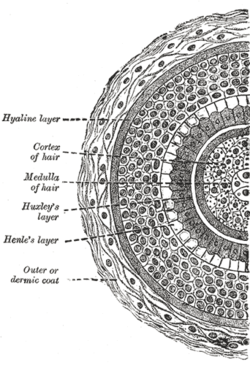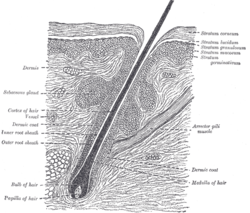Human hair
| Hair | |
|---|---|

Cross section of a hair
|
|

Strand of human hair at 200× magnification.
|
|
| Identifiers | |
| MeSH | D006197 |
| Code | TH H3.12.00.3.02001 |
| TA | A16.0.00.014 |
| FMA | 70752 |
|
Anatomical terminology
[]
|
|
| Root of the hair | |
|---|---|

Section of skin, showing the epidermis and dermis; a hair in its follicle; the Arrector pili muscle; sebaceous glands.
|
|
| Details | |
| Identifiers | |
| Latin | radix pili |
| Dorlands /Elsevier |
r_02/12687998 |
| TA | A16.0.00.014 |
| FMA | 70752 |
|
Anatomical terminology
[]
|
|
Hair is a protein filament that grows from follicles found in the dermis, or skin. Hair is one of the defining characteristics of mammals. The human body, apart from areas of glabrous skin, is covered in follicles which produce thick terminal and fine vellus hair. Most common interest in hair is focused on hair growth, hair types and hair care, but hair is also an important biomaterial primarily composed of protein, notably keratin.
Attitudes towards different hair, such as hairstyles and hair removal, vary widely across different cultures and historical periods, but it is often used to indicate a person's personal beliefs or social position, such as their age, sex, or religion.
The word "hair" usually refers to two distinct structures:
Hair fibers have a structure consisting of several layers, starting from the outside:
Each strand of hair is made up of the medulla, cortex, and cuticle. The innermost region, the medulla, is not always present and is an open, unstructured region. The highly structural and organized cortex, or middle layer of the hair, is the primary source of mechanical strength and water uptake. The cortex contains melanin, which colors the fiber based on the number, distribution and types of melanin granules. The shape of the follicle determines the shape of the cortex, and the shape of the fiber is related to how straight or curly the hair is. People with straight hair have round hair fibers. Oval and other shaped fibers are generally more wavy or curly. The cuticle is the outer covering. Its complex structure slides as the hair swells and is covered with a single molecular layer of lipid that makes the hair repel water. The diameter of human hair varies from 0.017 to 0.18 millimeters (0.00067 to 0.00709 in). There are two million small, tubular glands and sweat glands that produce watery fluids that cool the body by evaporation. The glands at the opening of the hair produce a fatty secretion that lubricates the hair.
...
Wikipedia
